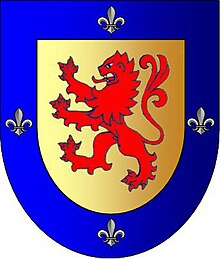Juan de Escalante
Juan de Escalante (* unknown; † approx . November 10, 1519 in Veracruz) was the commander of a ship during Hernán Cortés' expedition on the way from Cuba to the Aztec Empire ( Mexico ). Later he was in command of the garrison in Veracruz .
Diego Velázquez de Cuéllar , the governor of Cuba, financed the expedition and appointed Hernán Cortés as commander in chief.
voyage
The sea route was explored by Francisco Hernández de Córdoba in 1517 and by Juan de Grijalva in 1518 . Juan de Escalante took part in the expedition under Grijalva as captain of one of the four ships. However, the Spaniards were not yet able to establish settlements on the North American mainland during these expeditions. On February 18, 1519, the Cortés expedition set sail from Havana .
She made her first stop on the island of Cozumel and the men explored the new land. During the journey Juan de Escalante found out on the open sea that his ship was leaking and threatened to sink; he turned and turned back. Cortés then ordered the entire fleet to drive back to Cozumel. While Escalante's ship was being repaired, Gerónimo de Aguilar joined his Spanish compatriots. He had been held captive by the Mayas as a slave and later served Cortés well as an interpreter.
Colony establishment and death on the battlefield
In the bay of San Juan de Ulúa , in today's Mexico, Escalante supported the appointment of Cortés as captain general and the establishment of his own colony . In fact, the expedition broke away from Diego Velázquez de Cuéllar and submitted to the Spanish Emperor Charles V.
After Cortés had made an alliance with the Totonaks in Cempoala , he founded Villa Rica de la Vera Cruz in August 1519. Cortés made Juan de Escalante the first in command. Since he was also appointed mayor of the city, he was the first European to hold this post in mainland America.
Because some men did not want to take part in a campaign inland, Cortés commissioned Juan de Escalante and a few other men to destroy the ships and to bring the sails, ropes and compasses ashore. In doing so, he denied his men the opportunity to return to Cuba.
While Cortés was advancing further into the country and staying with Moctezuma II , the Aztecs demanded tribute from the peoples on the east coast . These peoples were under the protection of the small Spanish garrison in Veracruz. Their caciques complained to Escalante about the demands of the Aztecs and asked him for help. Escalante took his 40 men and faced the two thousand Aztecs on the battlefield. Two thousand Totonaks stood by his side, but they abandoned him at the first opportunity. In this battle Escalante was wounded, had to retreat to Veracruz and died shortly afterwards. Another six Spaniards and one of the two horses died in this battle.
Revenge of Hernán Cortés
One of Escalante's men (Arguello) was captured by the Aztecs and likely died of his wounds. His head was sent to Moctezuma, the Tlatoani of the Aztecs. When Cortés heard of the death of Escalante and his men, he took Moctezuma prisoner in his own palace and forced him to live in the palace that Moctezuma had assigned to the Spaniards in his capital Tenochtitlán . The Aztec commanders who fought with their warriors against Escalante had Cortés brought before them and publicly burned alive. Among them was Cuauhpopoca , the commandant of Nauhtlá . With this, Cortés clearly demonstrated who was in charge of Tenochtitlán from now on. With this act of revenge for the death of Juan de Escalante and his men, the lost reputation of the Spaniards in Veracruz and among the Totonacs returned.
Individual evidence
- ↑ Hernán Cortés: The Conquest of Mexico. Three reports to Emperor Charles V 1980, p. 26
- ^ Bernal Díaz del Castillo: History of the Conquest of Mexico. 1988, p. 76.
- ^ Bernal Díaz del Castillo: History of the Conquest of Mexico, 1988, p. 145
- ^ Bernal Díaz del Castillo: History of the Conquest of Mexico, 1988, p. 269
- ↑ Bernal Díaz del Castillo: History of the Conquest of Mexico, 1988, p. 276
Web links
- Veracruz
- Reports on Hernán Cortés
- Spanish biography of Juan de Escalante
- Hernán Cortés and the conquest of Mexico
- La Conquista
literature
- Hernán Cortés: The Conquest of Mexico. Three reports from Hernán Cortés to Emperor Charles V. Edited by Claus Litterscheid. Insel-Verlag, Frankfurt am Main 1980, ISBN 3-458-32093-8 ( Insel-Taschenbuch 393).
- Bernal Díaz del Castillo : History of the Conquest of Mexico. Edited and edited by Georg A. Narciß. Insel-Verlag, Frankfurt am Main 1988, ISBN 3-458-32767-3 ( Insel-Taschenbuch 1067), (Spanish original title: Historia verdadera de la conquista de la Nueva España ).
| personal data | |
|---|---|
| SURNAME | Escalante, Juan de |
| BRIEF DESCRIPTION | Spanish conquistador |
| DATE OF BIRTH | 15th century |
| DATE OF DEATH | November 10, 1519 |
| Place of death | Veracruz Mexico |


